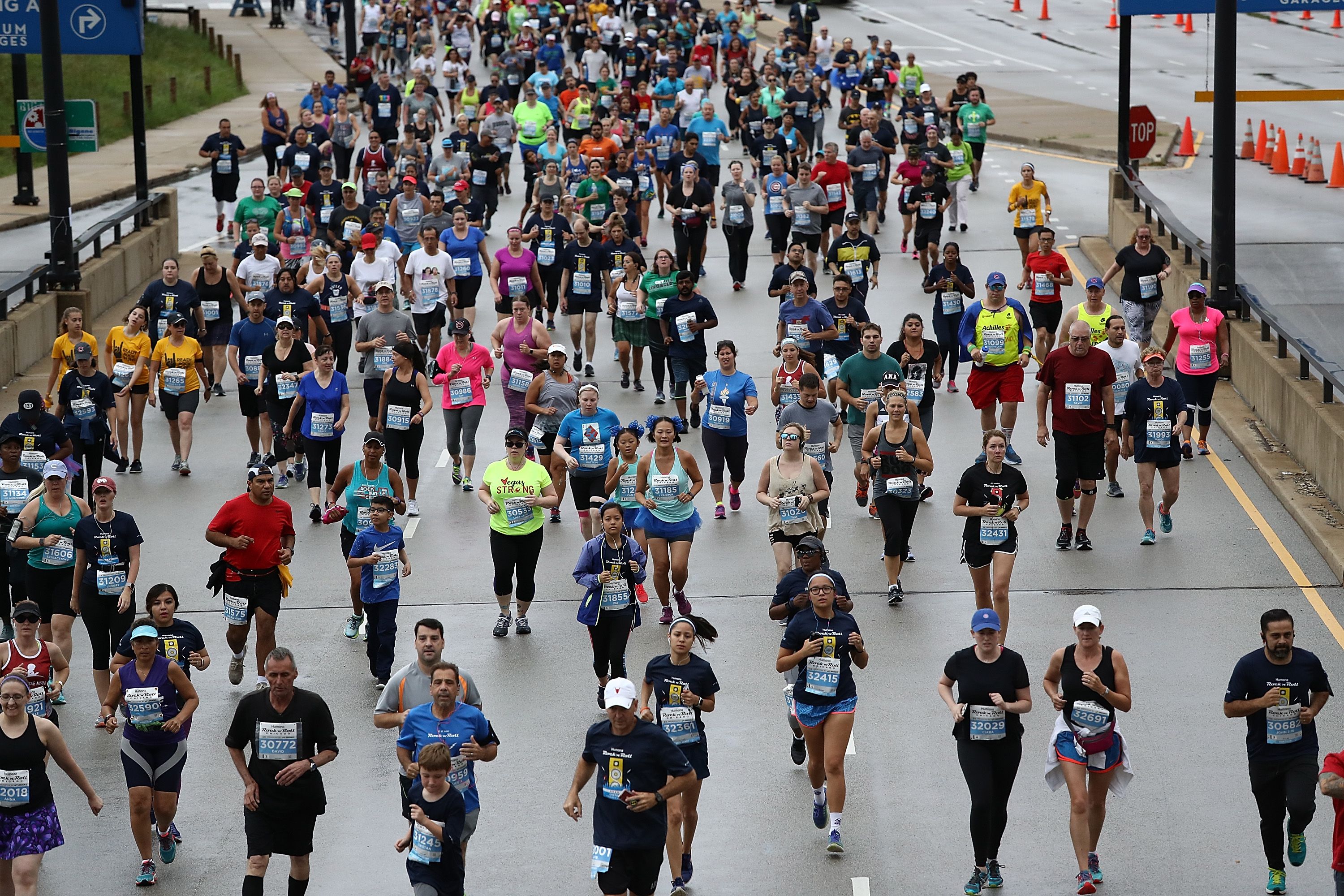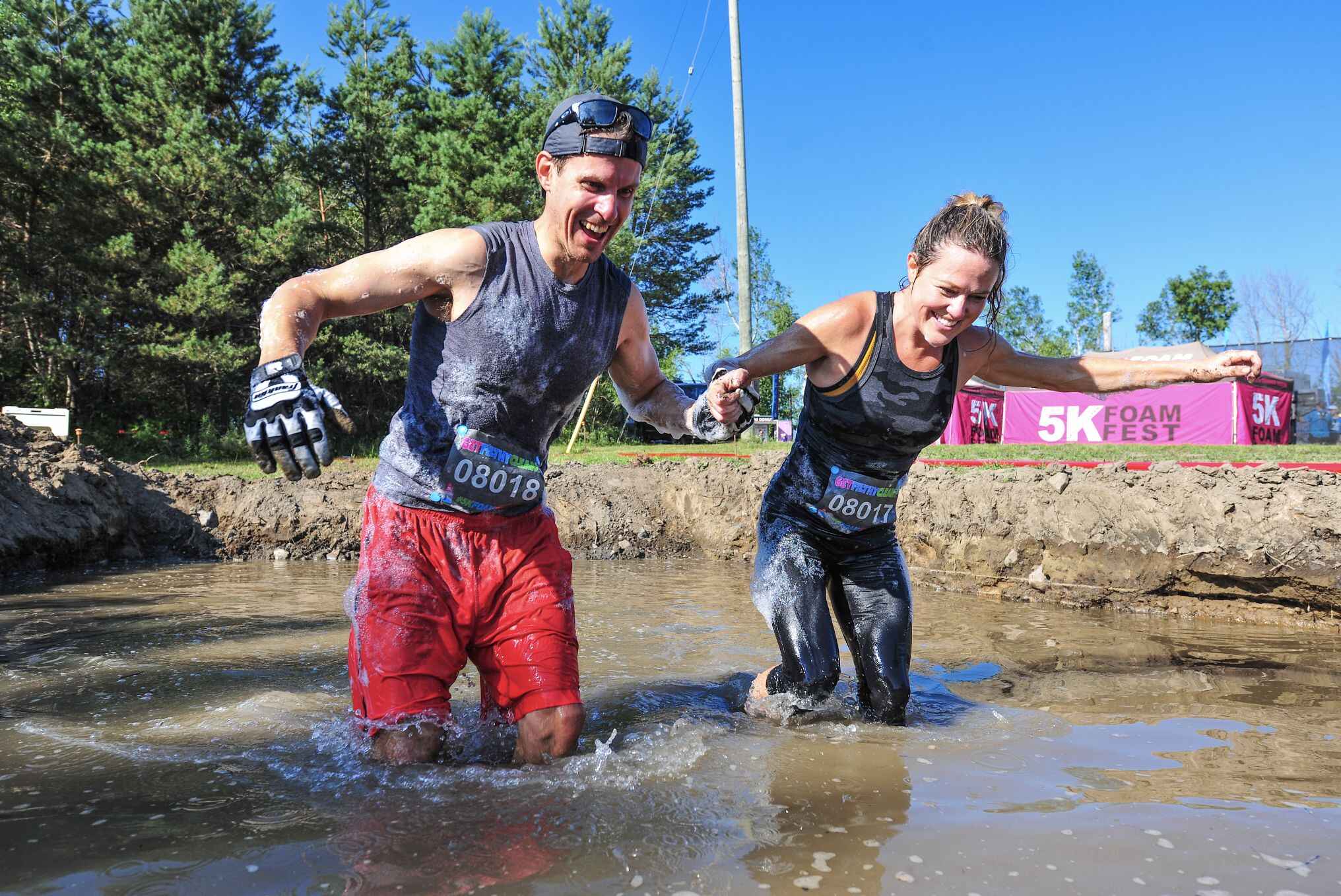Home>Misc>Featured>How Long Does It Take To Train For A 5K Run


Featured
How Long Does It Take To Train For A 5K Run
Modified: March 1, 2024
Train for a 5K run in record time with our featured program. Discover how long it takes to prepare for a 5K race and achieve your goals.
Introduction
How Long Does It Take To Train For a 5K Run?
Are you considering participating in a 5K run but unsure about how long it takes to properly train? Well, you’ve come to the right place! Training for a 5K run can be an exciting and rewarding journey, whether you are a seasoned runner looking to improve your performance or a beginner exploring the world of running for the first time.
A 5K run, also known as a 5-kilometer race, covers a distance of 5 kilometers or approximately 3.1 miles. It’s a popular choice for both recreational and competitive runners due to its manageable distance and accessibility for individuals of all fitness levels. One of the great things about 5K races is that they can be completed relatively quickly compared to longer distance races like half marathons or marathons.
However, it’s important to note that the time it takes to train for a 5K run can vary depending on several factors, including your current fitness level, previous running experience, and your specific goals. Whether you’re aiming to complete your first 5K or you’re looking to set a new personal record, having a well-structured training plan and dedication to consistent practice is key.
In this article, we will explore the various aspects of training for a 5K run, including setting realistic goals, assessing your current fitness level, designing a training plan, incorporating interval training, building endurance and stamina, strengthening muscles and preventing injuries, monitoring your progress, nutrition and hydration tips, rest and recovery, and preparing for race day. By the end, you will have the knowledge and tools to create an effective and enjoyable 5K training program that suits your needs and abilities.
Benefits of Training for a 5K Run
Training for a 5K run offers a multitude of benefits that go beyond just crossing the finish line. Whether you’re a beginner or an experienced runner, incorporating 5K training into your fitness routine can have a positive impact on both your physical and mental well-being. Here are some key benefits of training for a 5K run:
- Improved cardiovascular health: Running regularly helps to strengthen your heart and lungs, improving overall cardiovascular fitness. Training for a 5K run can lead to a lower resting heart rate, increased efficiency of oxygen transport, and better stamina.
- Weight management: Running is a great calorie-burning exercise. By training for a 5K run, you can increase your daily calorie deficit and potentially lose weight or maintain a healthy weight.
- Increased endurance and stamina: Training for longer distances helps you build endurance and stamina, enabling you to push past your limits and achieve new milestones.
- Stronger muscles and bones: Regular running helps to strengthen muscles and promote bone density, reducing the risk of osteoporosis and age-related muscle loss.
- Improved mental health: Running has been linked to reduced stress, anxiety, and depression. Training for a 5K run gives you a goal to focus on and a sense of accomplishment, boosting your mood and overall mental well-being.
- Increased self-confidence: Crossing the finish line of a 5K race can be a transformative experience. Training for and completing a 5K run can boost your self-confidence and provide a sense of achievement, motivating you to set and conquer new fitness goals.
- Opportunity for social connections: 5K races often attract a diverse range of participants, providing an opportunity to meet like-minded individuals, join running clubs, and build social connections centered around a common interest in running.
These benefits highlight the positive impact that training for a 5K run can have on your overall health and well-being. Whether you’re looking to improve your fitness level, manage your weight, boost your mental health, or find a sense of community, training for a 5K run can be a rewarding and transformative experience.
Setting Realistic Goals
When embarking on your 5K training journey, it is important to set realistic and achievable goals. Having clear goals in mind will not only provide direction to your training but also keep you motivated and focused throughout the process. Here are some tips for setting realistic goals for your 5K run:
- Assess your current fitness level: Take some time to evaluate your current fitness level and running abilities. Consider factors such as your running experience, average pace, and endurance. This self-assessment will help you set goals that are both challenging yet attainable.
- Identify your objectives: Determine what you want to achieve with your 5K run. It could be completing the race without stopping, improving your previous 5K time, or simply enjoying the experience. Setting specific objectives will give you a clear target to work towards.
- Consider your time frame: Take into account the amount of time you have available to train for the 5K run. If you have several months, you may have more flexibility to set more ambitious goals. However, if you have a shorter time frame, it may be more realistic to focus on smaller milestones.
- Break it down: Instead of solely focusing on the end result, break your goal down into smaller, manageable steps. This could include gradually increasing your running distance, improving your pace, or including specific training components like interval runs or hill workouts.
- Make it measurable: Set goals that are measurable and trackable. For example, aim to shave off a certain amount of time from your previous 5K run or run for a specific duration without taking a walk break. This way, you can monitor your progress and celebrate small victories along the way.
- Be flexible: It’s important to remain flexible with your goals. Life can sometimes throw unexpected challenges your way, and it’s okay to adjust your goals accordingly. Listen to your body and make adjustments as needed to prevent burnout or potential injuries.
Remember, setting realistic goals is key to your success and enjoyment during 5K training. While it’s important to challenge yourself, pushing too hard or setting goals that are unrealistic can lead to frustration and disappointment. Celebrate the small victories along the way and enjoy the journey towards achieving your goals.
Assessing Your Current Fitness Level
Before diving into a 5K training program, it’s essential to assess your current fitness level. A thorough assessment will help you determine your starting point and tailor your training plan to meet your specific needs and abilities. Here are some key factors to consider when assessing your current fitness level:
- Running experience: Evaluate your past experience with running. Have you never run before, or do you have some prior running experience? Understanding your running background will help you gauge your starting point and make appropriate adjustments to your training plan.
- Endurance and stamina: Assess your current endurance and stamina levels. How long can you comfortably run without feeling fatigued? Can you complete a continuous run for at least 20-30 minutes at a conversational pace? Understanding your endurance level will guide you in building an appropriate base.
- Pace and speed: Observe your running pace and speed. Are you consistently running at a slow and comfortable pace, or can you push yourself to run faster for short intervals? Knowing your baseline pace and speed will help you set realistic goals for increasing your running performance.
- Strength and flexibility: Consider your overall strength and flexibility. Do you have any muscular imbalances or areas of weakness? Assessing your strength and flexibility will help you incorporate appropriate cross-training exercises and strength training into your 5K training plan.
- Injury history: Take note of any previous injuries or ongoing concerns. Have you experienced any running-related injuries in the past? Understanding your injury history will allow you to take necessary precautions and include injury prevention exercises to minimize the risk of future setbacks.
By assessing your current fitness level, you will have a solid foundation for designing an effective and personalized 5K training plan. It will help you set realistic goals, determine the appropriate starting point for your workouts, and gauge your progress along the way. Remember to be honest with yourself during the assessment process and prioritize your safety and well-being throughout your 5K training journey.
Designing a Training Plan
Once you have assessed your current fitness level, it’s time to design a training plan that suits your needs and abilities. A well-structured training plan will help you progress gradually, build endurance, improve your running performance, and minimize the risk of injuries. Here are some key considerations when designing your 5K training plan:
- Set a schedule: Determine how many days per week you can commit to training. Aim for a minimum of three to four days to allow for proper rest and recovery.
- Include a variety of workouts: Incorporate a mix of endurance runs, tempo runs, interval training, and easy recovery runs into your training plan. This variety will help you improve different aspects of your running and prevent boredom.
- Gradually increase distance: Start with a comfortable running distance and gradually increase your mileage each week. Aim for around a 10% increase in total weekly mileage to avoid overexertion and minimize the risk of overuse injuries.
- Include rest days: Rest days are equally important as training days. Allow your body time to recover and repair by scheduling regular rest days within your training plan.
- Incorporate cross-training: Include cross-training activities such as cycling, swimming, or strength training to improve overall fitness, prevent overuse injuries, and enhance your running performance.
- Listen to your body: Pay attention to how your body feels during training. If you experience pain or persistent fatigue, it’s essential to listen to your body’s signals and adjust your training plan accordingly.
- Monitor progress: Keep track of your runs, distance covered, and times. Regularly assess your progress to determine if you are on track towards achieving your goals or if any adjustments to your training plan are necessary.
- Consider working with a coach: If you’re new to running or want personalized guidance, consider working with a running coach who can provide expert advice, help tailor a training plan to your specific needs, and provide motivation and accountability.
Remember, every individual is different, and what works for one person may not work for another. Be flexible with your training plan and be open to making adjustments along the way. A well-designed training plan will not only help you reach your 5K race goal but also ensure that you enjoy the process of training and continue to make progress in your running journey.
Incorporating Interval Training
Interval training is a powerful tool to incorporate into your 5K training plan. This type of workout involves alternating between periods of high-intensity effort and periods of active recovery. Incorporating interval training into your routine can help improve your overall running performance and increase your speed and endurance. Here’s how to effectively incorporate interval training into your 5K training plan:
- Choose the right distance: Determine the distance for your intervals based on your fitness level and goals. For beginners, shorter intervals of 200-400 meters may be more appropriate. For more experienced runners, longer intervals of 800-1600 meters can be challenging.
- Warm up properly: Before starting your interval workout, warm up your muscles with a slow jog and dynamic stretches. This will prepare your body for the higher intensity efforts and reduce the risk of injury.
- Set a work-to-rest ratio: Determine the ratio of work (high-intensity effort) to rest (active recovery). A common ratio for interval training is 1:1, where you perform the working interval at a challenging pace and then recover for an equal amount of time. As you progress, you can modify the ratio to increase or decrease the level of intensity.
- Vary your interval workouts: Mix up your interval workouts to prevent boredom and continuously challenge your body. Try different types of intervals, such as short sprints, longer repetitions, or pyramid workouts where you increase and then decrease the duration of the intervals.
- Focus on proper form: During the high-intensity intervals, maintain good running form with a slight forward lean, relaxed shoulders, and short, quick strides. This will help improve efficiency and reduce the risk of injury.
- Track your progress: Keep a record of your interval workouts, including distances covered, times, and perceived exertion levels. Regularly assess your progress to track improvements and adjust the intensity or duration of your intervals as needed.
- Gradually increase intensity: As you become comfortable with interval training, gradually increase the intensity of your efforts. This could mean running faster or increasing the distance covered during each interval, challenging your limits and pushing your boundaries.
- Include recovery days: Allow ample time for recovery between interval workouts. Intense interval training puts additional stress on your muscles and cardiovascular system, so make sure to schedule adequate rest days to prevent overtraining and reduce the risk of injury.
Incorporating interval training into your 5K training plan can be demanding, but the benefits are worth it. Interval training helps improve your speed, endurance, and overall running performance. Remember to gradually introduce interval workouts into your routine and listen to your body. With time and consistent effort, you will see progress and achieve better results in your 5K race.
Building Endurance and Stamina
Building endurance and stamina is a crucial aspect of your 5K training. By improving your endurance, you’ll be able to run longer distances at a consistent pace, while increasing your stamina will allow you to maintain a faster pace for a longer duration. Here are some effective strategies to develop endurance and stamina:
- Gradual mileage increase: Gradually increase your weekly mileage to build endurance. Aim for a weekly mileage increase of around 10% to avoid overexertion and reduce the risk of overuse injuries.
- Long, slow distance runs: Incorporate weekly long runs into your training plan to build endurance. Start with a distance that challenges you but is still manageable, then progressively increase the distance over time.
- Tempo runs: Include tempo runs in your training to improve stamina. Tempo runs involve running comfortably hard at a pace that is challenging but sustainable. This trains your body to maintain a faster pace over an extended period.
- Progressive runs: Add progressive runs to your training routine. Start at a comfortable pace and gradually increase your speed throughout the run. This helps simulate race conditions and develops the ability to maintain a strong pace as you fatigue.
- Hill training: Incorporate hill workouts to build strength and endurance. Hill repeats or running on hilly routes will challenge your cardiovascular system and leg muscles, preparing you for the demands of a 5K race.
- Interval training: Integrate interval workouts into your training plan to improve both speed and endurance. By alternating between high-intensity efforts and recovery periods, interval training helps develop cardiovascular fitness and anaerobic capacity.
- Cross-training: Include cross-training activities such as cycling, swimming, or using an elliptical machine to work different muscle groups and improve overall fitness. Cross-training can help prevent overuse injuries and provide a break from running while still enhancing endurance.
- Mind-body techniques: Practice mental strategies such as positive visualization, focused breathing, and mantra repetition to help push through fatigue and strengthen your mental resilience during long runs.
- Rest and recovery: Give your body enough time to rest and recover between training sessions. Adequate rest allows your muscles to repair and grow stronger, which is crucial for building endurance and stamina.
Building endurance and stamina takes time and consistent effort. Be patient with your progress and focus on gradually improving your running abilities. Remember, it’s important to listen to your body and adjust your training as needed to prevent overtraining and reduce the risk of injury. With dedication and a well-rounded training plan, you’ll be prepared to tackle the 5K race with confidence and resilience.
Strengthening Muscles and Preventing Injuries
Strengthening muscles and preventing injuries are vital components of your 5K training plan. By focusing on strengthening key muscles and implementing injury prevention strategies, you can improve your running performance and reduce the risk of common running-related injuries. Here are some effective ways to strengthen your muscles and prevent injuries:
- Incorporate strength training: Include strength training exercises in your routine to target muscle groups that are essential for running, such as the core, glutes, hamstrings, and calves. Resistance exercises like squats, lunges, deadlifts, planks, and calf raises can help improve strength and stability.
- Balance and stability work: Perform balance and stability exercises like single-leg squats, lateral lunges, and stability ball exercises to improve proprioception and strengthen the smaller, stabilizing muscles around your joints.
- Flexibility and mobility exercises: Incorporate dynamic warm-up exercises, such as leg swings, high knees, and walking lunges, to improve flexibility and mobility. Regular stretching after workouts, focusing on major muscle groups, can also help prevent muscle tightness and imbalances.
- Cross-training activities: Engage in cross-training activities such as yoga, Pilates, swimming, or cycling to work different muscle groups and prevent overuse injuries. These activities can improve overall strength, flexibility, and provide active recovery for your running muscles.
- Proper footwear: Invest in well-fitting running shoes that provide adequate support and cushioning for your feet. Visit a specialty running store to get properly fitted and choose shoes that suit your running style and foot biomechanics.
- Gradual mileage increase: Avoid sudden spikes in mileage, as this can overload your muscles and increase the risk of injuries. Gradually increase your mileage according to your training plan to allow your body to adapt to the increased demands.
- Listen to your body: Pay attention to any signs of pain, discomfort, or fatigue during or after your runs. Ignoring these warning signs can lead to more severe issues. Adjust your training accordingly, and don’t be afraid to take rest days or seek medical advice if necessary.
- Proper nutrition: Fuel your body with a balanced diet that includes ample protein, carbohydrates, and healthy fats. Proper nutrition aids in muscle recovery, repair, and overall performance.
- Hydration: Drink enough water before, during, and after your runs to maintain optimal hydration levels. Dehydration can increase the risk of muscle cramps and fatigue, affecting both your performance and injury prevention.
- Form and technique: Pay attention to your running form and technique. Avoid overstriding, maintain an upright posture, and aim for a midfoot or forefoot strike. Proper form helps distribute the stress evenly throughout your body, reducing the risk of injuries.
By incorporating these strategies into your training plan, you can strengthen your muscles, improve your running efficiency, and minimize the risk of injuries. Remember to prioritize your body’s well-being, listen to any warning signs, and make necessary adjustments to your training routine. By taking care of your muscles and preventing injuries, you’ll be able to continue progressing and achieving your goals throughout your 5K training and beyond.
Monitoring Your Progress
Monitoring your progress during your 5K training is important to track your improvement, stay motivated, and make necessary adjustments to your training plan. By regularly assessing your performance and monitoring key indicators, you can gauge your progress and ensure that you are on track towards achieving your goals. Here are some effective ways to monitor your progress:
- Keep a training journal: Maintain a training journal to record your workouts, including distances, times, and perceived effort levels. This allows you to track your consistency, identify patterns, and assess your progress over time.
- Use a running app or GPS watch: Utilize running apps or GPS watches to track and analyze your running data, including distance, pace, and elevation. These tools provide real-time feedback and allow you to compare your performance on different runs.
- Perform regular fitness assessments: Conduct regular fitness assessments to measure your progress. This can include timed runs at specific distances, such as a timed 5K or mile, to determine improvements in your speed and endurance.
- Track your heart rate: Monitor your heart rate during runs to gauge your effort levels. As your fitness improves, you should see a decrease in your heart rate for a given pace or effort, indicating improved cardiovascular fitness.
- Assess your perceived effort: Pay attention to your perceived effort during runs. As your training progresses, you may find that the same pace or distance feels easier or more comfortable, indicating an improvement in your overall fitness level.
- Set mini-goals: Break down your larger goals into smaller, achievable mini-goals. These can be weekly or monthly targets, such as increasing your long run distance or improving your race pace. Meeting these mini-goals provides a sense of accomplishment and boosts motivation.
- Seek feedback: Seek feedback from a running coach or experienced runners. They can provide valuable insights on your form, technique, and training plan, helping you identify areas for improvement and make necessary adjustments.
- Listen to your body: Pay attention to how your body feels during and after runs. Notice any improvements in your energy levels, recovery time, or overall well-being. This intuitive feedback can provide additional information about your progress.
- Track non-running metrics: Consider tracking non-running metrics such as body weight, body measurements, or sleep quality. While these factors may not directly measure running performance, they can reflect your overall health and well-being, which can impact your training progress.
Remember, progress looks different for everyone, and it’s important to focus on your individual journey rather than comparing yourself to others. Be patient, trust the process, and celebrate each milestone along the way. By monitoring your progress, you can stay motivated and continuously fine-tune your training plan to optimize your 5K performance.
Nutrition and Hydration Tips
Proper nutrition and hydration play a crucial role in your 5K training, helping to fuel your workouts, support recovery, and optimize your overall performance. Here are some tips to ensure you’re giving your body the right nutrients and staying hydrated throughout your training:
- Eat a balanced diet: Focus on consuming a well-balanced diet that includes a variety of whole foods. Aim for a combination of carbohydrates, protein, and healthy fats to provide the necessary fuel and nutrients for your training.
- Timing is key: Be mindful of your meal timing. Eat a balanced meal containing carbohydrates, protein, and healthy fats 2-3 hours before your runs to provide energy and prevent discomfort. For shorter runs, a small snack 30-60 minutes beforehand may suffice.
- Stay hydrated: Hydrate adequately before, during, and after your runs. Drink water throughout the day to maintain optimal hydration levels. During longer runs, consider using a hydration belt, carrying a handheld water bottle, or planning routes with water fountains or hydration stations.
- Replenish electrolytes: When running for longer durations or in hot weather, consider replenishing electrolytes lost through sweat. You can consume electrolyte-rich drinks or include foods like bananas, oranges, and sports gels that contain electrolytes.
- Refuel post-run: Consume a post-run meal or snack within 30-60 minutes after your training session. This meal should contain a mix of carbohydrates and protein to aid in muscle recovery and replenish glycogen stores.
- Prioritize complex carbohydrates: Prioritize complex carbohydrates, such as whole grains, fruits, and vegetables, as they provide sustained energy and essential nutrients. Avoid relying heavily on simple sugars, which can cause energy spikes and crashes.
- Include lean protein: Include lean protein sources like chicken, fish, tofu, beans, and legumes to support muscle repair and recovery. Protein also helps keep you feeling satisfied and aids in muscle development.
- Load up on fruits and vegetables: Fruits and vegetables are packed with vitamins, minerals, and antioxidants that support overall health and aid in recovery. Aim for a colorful variety to obtain a wide range of nutrients.
- Practice portion control: Pay attention to portion sizes to maintain a healthy balance. Avoid overeating or undereating, as both can negatively impact your energy levels and performance.
- Listen to your body: Everyone’s nutritional needs can vary, so it’s important to listen to your body’s cues. Experiment with different foods and timing to determine what works best for you during training. Make adjustments as needed to optimize your performance.
Remember, nutrition and hydration are highly individualized, so what works for one person may not work for another. It’s important to find a balance and establish healthy eating and drinking habits that support your training and overall well-being. Consider consulting a registered dietitian who specializes in sports nutrition for personalized guidance.
Rest and Recovery
Rest and recovery are essential components of any successful 5K training plan. Giving your body adequate time to rest and recover is just as important as the training itself. Proper rest helps prevent overtraining, reduces the risk of injury, and allows your body to adapt and become stronger. Here are some key considerations for incorporating rest and recovery into your training:
- Schedule rest days: Plan regular rest days throughout your training week. These rest days allow your body to repair and rebuild muscles, replenish energy stores, and reduce the risk of overuse injuries.
- Listen to your body: Pay attention to the signals your body sends. If you feel excessively fatigued, experience persistent muscle soreness, or notice any pain or discomfort, it may be a sign that you need additional rest. Adjust your training schedule as needed to prioritize recovery.
- Get enough sleep: Adequate sleep plays a vital role in recovery and optimizing athletic performance. Aim for 7-9 hours of quality sleep per night to allow your body to repair and rejuvenate.
- Active recovery: Incorporate active recovery activities on rest days. Engage in low-impact exercises like walking, gentle stretching, or yoga to promote blood flow, reduce muscle stiffness, and aid in the recovery process.
- Massage or foam rolling: Use self-massage techniques or foam rollers to relieve muscle tension and improve circulation. These techniques can help alleviate soreness and promote recovery.
- Hydrate properly: Stay hydrated throughout the day to support the recovery process. Hydration is crucial for optimal muscle function, nutrient delivery, and waste removal.
- Practice stress management: Incorporate stress-reducing activities such as meditation, deep breathing exercises, or hobbies that help you relax and unwind. Chronic stress can hinder recovery and negatively impact performance.
- Listen to your emotions: Allow yourself time for mental and emotional recovery. Engage in activities that bring you joy, spend time with loved ones, or pursue non-running interests to maintain a healthy balance in your life.
- Periodize your training: Implement a periodization approach to your training plan. This involves organized cycles of training intensity and volume, allowing for periods of increased and decreased intensity to balance stress and recovery.
- Seek professional help if needed: If you experience persistent fatigue, difficulty recovering, or recurring injuries, it may be helpful to consult with a sports medical professional or a qualified coach who can provide guidance and support.
Remember, rest and recovery are not signs of weakness but rather essential components of a well-rounded training plan. Embrace the rest days and recovery practices as an opportunity to recharge both your body and mind. By prioritizing rest, you’ll optimize your physical adaptation, reduce the risk of injury, and ensure long-term progress in your 5K training.
Preparing for Race Day
The day of your 5K race is an exciting culmination of all your training efforts. Proper preparation is key to ensure you have a successful and enjoyable race day experience. Here are some tips to help you prepare for race day:
- Review the race details: Familiarize yourself with the race course, start time, and any specific rules or instructions provided by the race organizers. Plan your logistics accordingly, including transportation, parking, and any necessary gear or equipment.
- Taper your training: In the days leading up to the race, reduce the intensity and volume of your training. This tapering period allows your body to fully recover and be fresh on race day.
- Get enough sleep: Prioritize a good night’s sleep before race day. Aim for 7-9 hours of quality sleep to ensure you wake up rested and energized.
- Eat a light and balanced meal: Consume a light and easily digestible meal 2-3 hours before the race. Include carbohydrates for energy and a moderate amount of protein to aid in muscle recovery.
- Hydrate properly: Drink water in the hours leading up to the race to ensure you are well-hydrated. Avoid excessive caffeine or alcohol, as they can dehydrate you.
- Arrive early: Plan to arrive at the race venue with ample time to check-in, warm up, and mentally prepare. Give yourself enough time to use the restroom and familiarize yourself with the race environment.
- Warm up properly: Perform a dynamic warm-up routine to activate your muscles and increase your heart rate. Include exercises like jogging, high knees, leg swings, and dynamic stretches.
- Set realistic goals: Set realistic and attainable goals for your race. Consider both performance-based goals, such as achieving a specific time, and process-based goals, such as maintaining good form or enjoying the race experience.
- Follow your race plan: Stick to the race strategy you’ve practiced during training. Pace yourself appropriately, starting conservatively and gradually increasing your effort throughout the course.
- Stay positive and focused: Maintain a positive mindset and stay focused on your race. Use visualization techniques to imagine yourself crossing the finish line strong and achieving your goals.
- Stay hydrated during the race: Utilize the water stations along the race course to stay hydrated. Take small sips of water or sports drinks to avoid discomfort or cramping.
- Revel in the experience: Enjoy the race day experience! Take in the sights and sounds, cheer on fellow runners, and embrace the sense of accomplishment as you cross the finish line.
Remember, race day is about celebrating your hard work and enjoying the experience. Trust in your training, stay confident, and have fun. Whether it’s your first 5K or a new personal best, savor the moment and be proud of your achievement!
Conclusion
Congratulations on embarking on your journey to train for a 5K run! As you’ve learned throughout this article, training for a 5K requires dedication, consistency, and a well-designed plan. By setting realistic goals, assessing your current fitness level, incorporating interval training, building endurance and stamina, strengthening muscles, monitoring your progress, and taking care of your nutrition, hydration, rest, and recovery, you are well on your way to a successful 5K race.
Keep in mind that the 5K training experience is unique to each individual, and it’s important to listen to your body, adapt your training plan as necessary, and find joy in the process. Along the way, you may face challenges, setbacks, or moments of doubt, but perseverance and commitment will ultimately lead you to the finish line.
Remember to celebrate your achievements, whether it’s completing your first training run, hitting a new personal record, or simply enjoying the journey of becoming a stronger and healthier runner. Embrace the excitement of race day, and most importantly, have fun!
As you cross the finish line of your 5K race, take pride in the progress you’ve made and the commitment you’ve shown. Remember that this is just the beginning of your running journey, as there are many more distances and goals you can conquer in the future.
So lace up your running shoes, set your sights on the finish line, and enjoy the exhilarating experience of training for and participating in a 5K run. You’ve got this! Good luck and happy running!









